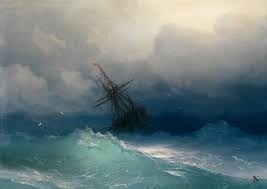ABOUT AQUARIAN PAINTING TECHNIQUE (part 5)
 This is confirmed by laboratory tests. Today, there are world-famous manufacturers who honor the traditions of the best manufactories, they have earned the high trust and respect of professionals. Information on the quality of the paint used can always be found by marking on its packaging. Knowing some of the laws of mixing, studying the behavior of paints of different companies and work experience will suggest the preferred choice of paints.
This is confirmed by laboratory tests. Today, there are world-famous manufacturers who honor the traditions of the best manufactories, they have earned the high trust and respect of professionals. Information on the quality of the paint used can always be found by marking on its packaging. Knowing some of the laws of mixing, studying the behavior of paints of different companies and work experience will suggest the preferred choice of paints.
Another stereotype is related to paper quality. You can read a lot of interesting things from the history of paper production and its application. Without delving into history and moving on to practical recommendations, let’s say that a modern watercolorist has a wide selection of professional paper. Continue reading
ABOUT AQUARIAN PAINTING TECHNIQUE (part 4)
 But with the beginning of the technical revolution, with the advent of industrial methods for the manufacture of materials, broader opportunities arose for creative experiments and the popularization of watercolor painting.
But with the beginning of the technical revolution, with the advent of industrial methods for the manufacture of materials, broader opportunities arose for creative experiments and the popularization of watercolor painting.
Newer and cheaper materials have made this technique fragile and more vulnerable to storage. Perhaps that is why for a long time watercolor still remained an independent form of painting and was the lot of fans of plein air painting as a particularly delicate aesthetic pleasure obtained during outdoor recreation.
The perception of watercolors was often associated with the idea of some very simple, affordable and even frivolous way of painting, more suitable for the initial stage of training, preceding the training in oil technology. Continue reading
ABOUT AQUARIAN PAINTING TECHNIQUE (part 3)
 The foregoing applies to any kind of art, but it is watercolor that is particularly susceptible to temperament and the “movement of the brush” emanating from the movement of the spirit of the master. It denotes a creative, mental and philosophical attitude to the material. This is the main secret and the problem of ownership of equipment. A high concentration of energy, self-control, a clear thought, a clear task, and a subtle sense of water, colors, and paper are the qualities of a painter that are necessary for the embodiment of an image in a whimsical watercolor painting.
The foregoing applies to any kind of art, but it is watercolor that is particularly susceptible to temperament and the “movement of the brush” emanating from the movement of the spirit of the master. It denotes a creative, mental and philosophical attitude to the material. This is the main secret and the problem of ownership of equipment. A high concentration of energy, self-control, a clear thought, a clear task, and a subtle sense of water, colors, and paper are the qualities of a painter that are necessary for the embodiment of an image in a whimsical watercolor painting.
A good illustration of what has been said is a brief acquaintance with one of the traditional pictorial techniques of the East. In China and Japan, there are ancient traditions of writing with water-based materials, mostly ink painting. The traditions of the East are very different from European ones. Continue reading
ABOUT AQUARIAN PAINTING TECHNIQUE (part 2)
 Incidentally, the generally accepted term “watercolor” was first used by Chennino Chennini in his Treatise on Painting (1437), the main point in the described process was the dissolution of paint in water containing vegetable gum – gummi.
Incidentally, the generally accepted term “watercolor” was first used by Chennino Chennini in his Treatise on Painting (1437), the main point in the described process was the dissolution of paint in water containing vegetable gum – gummi.
So, from the history of technology it is clear that the first method of watercolor writing was painting on dry soil, another way of working, on the wet surface of the paper, was supposedly applied not earlier than the beginning of the 19th century. A more capricious and whimsical way of writing wet was born in England, probably because in a country located on an island surrounded by water in this “foggy Albion”, the increased humidity of the air itself dictated the painting’s character light and soft. Continue reading
ABOUT AQUARIAN PAINTING TECHNIQUE (part 1)
 The element of water and paint
The element of water and paint
Despite the availability and prevalence, the watercolor technique remains mysterious and incomprehensible to many, both amateurs and professional artists. Despite the apparent lightness, this material, which is natively associated with water, because of its disobedience and spontaneity, creates many problems for those who neglect the need for patient study.
Starting the story about the watercolor technique, you need to recall what, in fact, means “watercolor” in the dictionary sense, since the key to understanding lies in the word itself. Continue reading



